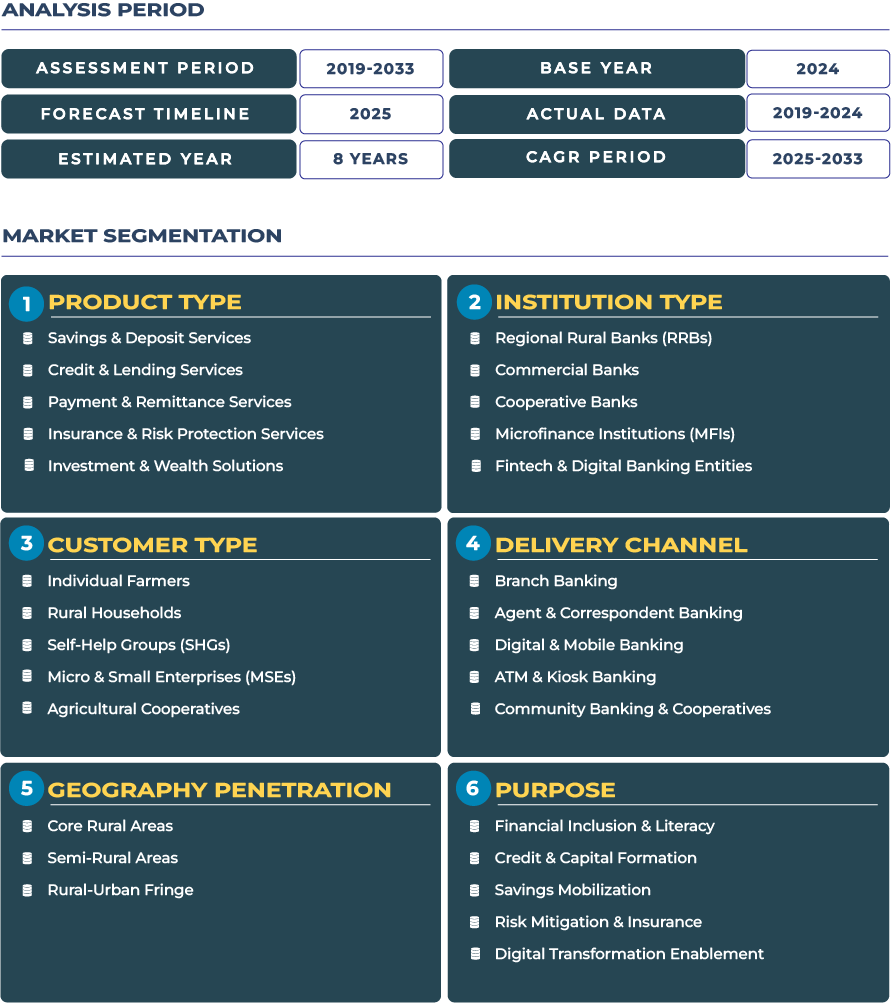Peru’s High-Altitude Rural Banking Revolution: Financing Growth Above the Clouds
Peru rural banking market is undergoing a structural transformation shaped by its unique geography and high-altitude agricultural economy. From the Andean plateaus to the coffee and quinoa farms of Cusco and Puno, Peru’s financial institutions are building adaptive lending models tailored to niche agricultural exports and cooperative networks. As farmers cultivate in terrains exceeding 3,000 meters, the need for specialized financial instruments that address logistical challenges, certification costs, and export cycles has grown sharply. The Peru rural banking industry is expected to rise from USD 7.6 billion in 2025 to USD 11.6 billion by 2033, expanding at a robust CAGR of 5.4%. This sustained growth reflects the interplay of agro-export modernization, microfinance innovation, and community-based savings ecosystems that define the country’s rural financial resilience.
Note:* The market size refers to the total fees/revenue generated by banks through various services.
Peru Rural Banking Market Outlook: Altitude-Adapted Credit Systems Fuel Agricultural Transformation
The rural banking sector in Peru stands as a crucial enabler of high-altitude agricultural productivity. By financing specialty crops such as coffee, cocoa, and quinoa, often certified under Fair Trade or organic standards, rural banks are linking finance to international demand. Financial entities like Agrobanco and regional microfinance institutions are leveraging data-driven loan evaluations and mobile credit distribution to penetrate remote areas. The country’s export-linked lending model integrates certification-based pre-finance, enabling small producers to meet export quality standards while improving income stability. Such hybrid models are particularly relevant in rural zones affected by climate variability and post-pandemic income shocks.
Moreover, the government’s rural financial inclusion programs, supported by Ministerio de Economía y Finanzas (MEF) and de Desarrollo Agrario y Riego (MIDAGRI), have played an instrumental role in expanding access to rural banking services. By promoting the digitalization of savings, insurance, and payment services, these programs are bridging the financial gap for underserved communities. This inclusive ecosystem is allowing Peru’s rural financial architecture to scale sustainably, anchored by community trust, cooperative capital, and export-driven market stability.
Drivers & Restraints: High-Value Crop Financing Amid Structural Challenges
Premium agro-export potential has emerged as the core growth driver for the Peru rural banking ecosystem. The rise of global demand for high-quality Andean crops such as quinoa, coffee, and maca has incentivized banks to extend customized credit lines. Rural cooperatives, often supported by NGOs and agritech intermediaries, are facilitating access to finance through group-based collateral systems. Additionally, successful models of micro-insurance, like those designed for frost and drought risk, are increasing credit security for both lenders and borrowers. The collaboration between development finance institutions and local savings cooperatives enhances the capital base available to small producers, enabling modernization of tools, irrigation, and post-harvest facilities.
However, geographic remoteness and limited collateralization capacity remain key constraints in Peru rural banking sector. High transport costs, irregular road access, and informal land tenure hinder farmers from meeting formal lending requirements. Moreover, the volatility of export prices and occasional political disruptions challenge repayment schedules and interest-rate management. While fintech penetration is improving, the uneven distribution of connectivity across mountainous regions slows the pace of digital finance expansion. As a result, sustained institutional support and regulatory flexibility are vital to strengthen the sector’s ability to manage credit risk and maintain profitability in isolated territories.
Trends & Opportunities: Specialty-Crop Finance and Cooperative Scaling Define the Next Decade
The Peru rural banking landscape is experiencing dynamic transformation driven by specialty-crop financing and cooperative digital scaling. Rural banks are increasingly structuring credit products linked to certification processes such as Fair Trade, Rainforest Alliance, and organic standards. By pre-financing certification costs, banks are reducing barriers for smallholders to access premium global markets. Additionally, the rapid expansion of community-based savings and loan associations (CSLAs) has created localized financial resilience. These associations are enabling collective financial management, micro-investment, and savings mobilization in high-altitude communities where formal banking infrastructure remains limited.
Opportunities abound in cold-chain finance and certification-linked pre-finance mechanisms. The development of altitude-adapted cold-chain logistics, crucial for preserving coffee and fruit quality, is attracting investment from Peru’s export credit agencies. In August 2025, COFIDE, the national development bank, announced partnerships with rural financial institutions to finance micro cold-chain units in Andean regions. These units ensure product freshness, extend market reach, and secure repayment through value-chain integration. Likewise, certification pre-finance models enable farmers to access global buyers faster, strengthening Peru’s position in the specialty agro-export market.
Competitive Landscape: Cooperative Innovation Meets Export-Finance Integration
The competitive environment in the Peru rural banking industry is characterized by increasing collaboration between microfinance institutions, cooperatives, and export agencies. Local financial leaders such as Agrobanco and Caja Arequipa continue to strengthen their digital and community outreach. By offering remote mobile banking, indexed savings accounts, and micro-insurance, they are reshaping access to financial tools in mountainous and Amazonian regions. The entry of private digital lenders has further intensified competition, pushing legacy cooperatives to modernize governance and data infrastructure. Collectively, these developments point toward a hybrid ecosystem where digital, cooperative, and export-linked finance converge to build a resilient and inclusive rural banking landscape.







